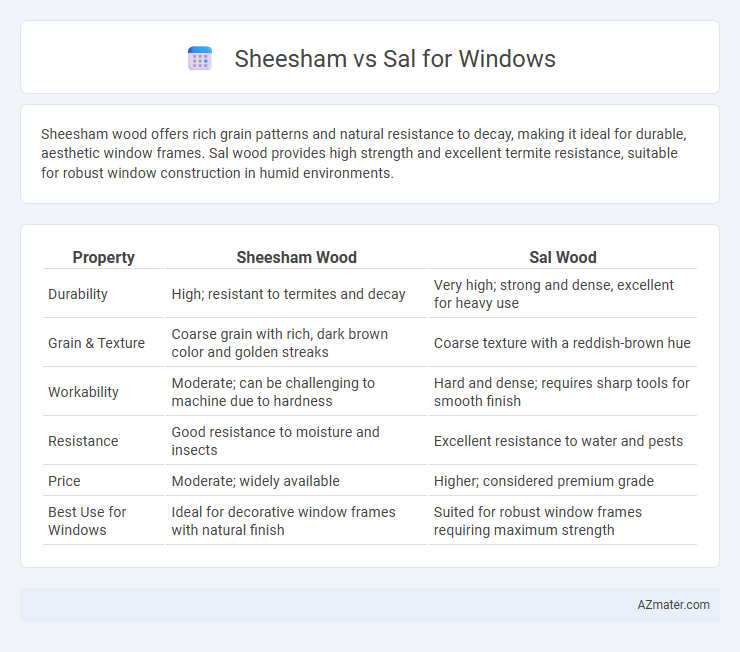Sheesham wood offers rich grain patterns and natural resistance to decay, making it ideal for durable, aesthetic window frames. Sal wood provides high strength and excellent termite resistance, suitable for robust window construction in humid environments.
Table of Comparison
| Property | Sheesham Wood | Sal Wood |
|---|---|---|
| Durability | High; resistant to termites and decay | Very high; strong and dense, excellent for heavy use |
| Grain & Texture | Coarse grain with rich, dark brown color and golden streaks | Coarse texture with a reddish-brown hue |
| Workability | Moderate; can be challenging to machine due to hardness | Hard and dense; requires sharp tools for smooth finish |
| Resistance | Good resistance to moisture and insects | Excellent resistance to water and pests |
| Price | Moderate; widely available | Higher; considered premium grade |
| Best Use for Windows | Ideal for decorative window frames with natural finish | Suited for robust window frames requiring maximum strength |
Introduction to Sheesham and Sal Wood
Sheesham wood, also known as Indian rosewood, is highly valued for its durability, rich grain patterns, and natural resistance to decay, making it an excellent choice for window frames. Sal wood, derived from the Shorea robusta tree, is prized for its hardness, strength, and weather-resistant properties, providing robust protection and longevity in window construction. Both woods offer distinct benefits, with Sheesham favored for its aesthetic appeal and Sal noted for its structural resilience.
Physical Properties Comparison
Sheesham wood, also known as Indian Rosewood, offers high density around 800-900 kg/m3, providing excellent strength and durability for window frames, while Sal wood features a slightly lower density of approximately 720-850 kg/m3, contributing to its robust and hard texture. Sheesham possesses superior natural oil content, enhancing resistance to decay and termites, whereas Sal wood is known for its exceptional hardness and wear resistance, making both woods durable in outdoor environments. Sheesham typically exhibits a finer grain with moderate dimensional stability, contrasting with Sal's coarse grain and higher shrinkage rates, influencing long-term maintenance and finish quality of windows.
Durability and Longevity
Sheesham wood, known for its high density and natural oils, offers exceptional durability and resistance to moisture, making it ideal for long-lasting window frames. Sal wood, though strong and dense, is more prone to insect attacks and requires regular treatment to maintain its longevity in window applications. Choosing Sheesham ensures extended durability and minimal maintenance compared to Sal, especially in humid or exposed environments.
Resistance to Termites and Pests
Sheesham wood exhibits high natural resistance to termites and pests, making it ideal for durable window frames in pest-prone areas. Sal wood also offers considerable termite resistance but is generally less effective compared to Sheesham due to its coarser grain structure. Choosing Sheesham ensures longer-lasting protection against wood-boring insects, enhancing the lifespan of window installations.
Aesthetic Appeal and Grain Patterns
Sheesham wood offers a rich, golden-brown hue with distinctive dark streaks, creating a warm and elegant aesthetic ideal for window frames that complement traditional and rustic interiors. Sal wood features a more uniform grain with a subtle coarse texture, producing a sturdy and understated look suited for contemporary designs prioritizing durability. Both woods exhibit unique grain patterns, but Sheesham's pronounced veining delivers a more decorative appeal compared to Sal's relatively consistent and subtle grain.
Workability and Maintenance
Sheesham wood offers excellent workability due to its fine grain and moderate hardness, making it easier to cut, carve, and shape for window frames. Sal wood is denser and harder, which can pose challenges during installation but provides superior durability and resistance to wear over time. Maintenance for Sheesham windows involves regular polishing to preserve its natural luster, while Sal requires minimal upkeep due to its natural resistance to decay and pests.
Environmental Impact and Sustainability
Sheesham wood, harvested from Dalbergia species, is known for its durability and natural resistance but often faces sustainability challenges due to overharvesting and slow growth rates. Sal wood, sourced from Shorea robusta, grows more quickly and is managed in certified plantations, making it a more environmentally sustainable choice for window frames. Choosing Sal wood reduces deforestation pressure and promotes responsible forestry, contributing to lower carbon footprints and better ecological balance compared to Sheesham.
Cost Analysis: Sheesham vs Sal
Sheesham wood typically costs more than Sal wood due to its finer grain and richer color, making it a premium choice for windows. Sal wood offers a more budget-friendly option with greater durability and resistance to decay, which can reduce maintenance expenses over time. Evaluating the lifecycle cost of Sheesham versus Sal windows highlights that initial price differences may be offset by Sal's longevity and sturdier nature.
Suitability for Window Frames
Sheesham wood offers high durability and natural resistance to pests, making it suitable for sturdy window frames in regions with moderate humidity. Sal wood provides exceptional strength and wear resistance, ideal for heavy-duty window frames subjected to harsh weather conditions or frequent use. Both woods require proper treatment and sealing to enhance longevity and prevent moisture damage in window applications.
Conclusion: Making the Right Choice
Sheesham wood offers rich texture and natural oils that provide durability and resistance to decay, making it ideal for elegant window frames in humid environments. Sal wood boasts exceptional hardness and strength, perfect for windows requiring robust structural support and long-term stability. Choosing between Sheesham and Sal depends on balancing aesthetic appeal and environmental conditions with the need for strength and longevity in window construction.

Infographic: Sheesham vs Sal for Window
 azmater.com
azmater.com